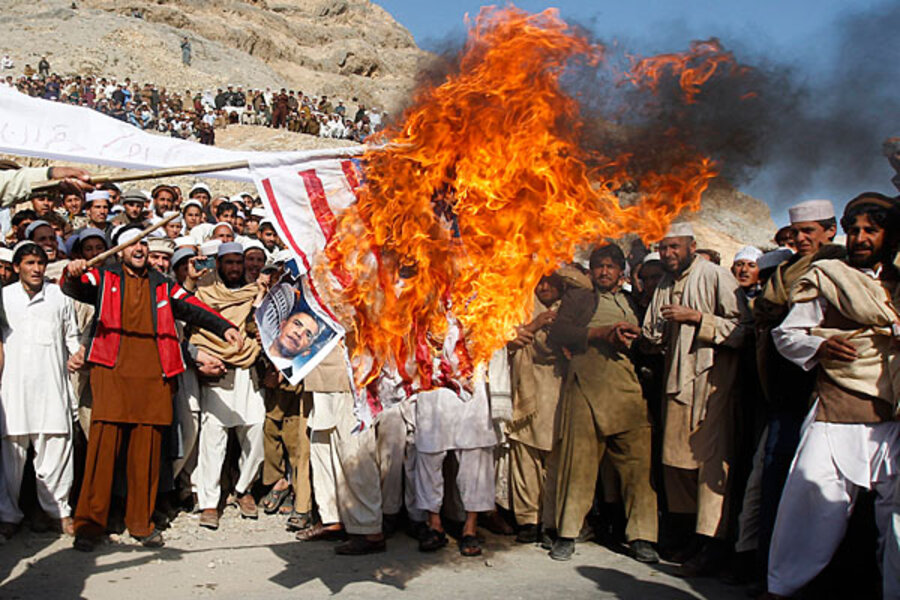Quran burning report a window on growing Afghan-on-US violence
Loading...
| WASHINGTON
The findings released Monday of a Pentagon investigation into February’s burnings of Qurans by US soldiers in Afghanistan could hardly have been more timely. They come out at the end of the worst month for killings of US forces by their Afghan counterparts of the 11-year war.
The investigation offers a sobering picture of the kind of distrust and cultural misunderstanding between US and Afghan forces that, in the case of the Quran burnings, led to deadly riots in Afghanistan. More generally, it helps to explain the growing number of so-called “green-on-blue” incidents, in which Afghan soldiers and police turn on their US and coalition counterparts.
Twelve US military personnel have been killed by Afghan soldiers or police this month, bringing the number of coalition forces killed in such incidents this year to more than 40 – the deadliest for such incidents of the war.
In the report, Army Brig. Gen. Bryan Watson says he is convinced that US soldiers who oversaw the incineration that included as many as 100 Qurans did not act with “malicious intent” designed “to defame the faith of Islam.” But the report castigates US military officers and senior enlisted personnel in charge at the US prison at Bagram air base where the burning took place.
He also says that US soldiers disregarded an Afghan officer and an interpreter who tried to tell them that burning the Quran would be viewed by Afghans as a desecration of Islam’s holiest text. “That US service members did not heed the warnings of their [Afghan] partners is, perhaps, my biggest concern,” General Watson writes.
The Army announced that six soldiers would receive administrative punishment for their roles in the incineration.
Also on Monday, the Pentagon announced disciplinary action against three Marines for their participation in a video that shows Marines from the 3rd Battalion, 2nd Marine Regiment urinating on the dead bodies of Taliban fighters. The video, which reportedly dates from last year, surfaced on the web in January and kindled anger in Afghanistan.
The Quran burning and urination incident are two extreme examples of the kinds of actions that Afghans cite to explain why more Afghan soldiers and police are turning their weapons on their US and coalition partners.
US officials say that some of the attacks are the work of Taliban fighters who enlist in the rapidly growing Afghan forces for the sole purpose of killing Americans once they are “inside the wire.” The top US commander in Afghanistan, Gen. John Allen, told reporters in a video press conference last week that as many as a quarter of the incidents are the work of Taliban or Taliban sympathizers infiltrating the Afghan forces.
General Allen also noted that Afghan soldiers are under particular stress in August this year because Ramadan is under way, when Muslims are not to eat or drink until after sundown. Other Afghanistan experts countered by noting that Ramadan occurred in each of the previous years of the war without the corresponding spike in green-on-blue attacks.
Allen has ordered all US military personnel in Afghanistan to carry a loaded weapon with them at all times.
He acknowledged – and most outside experts concur – that most of the “insider attacks” appear to be the result of growing resentments and frictions that build up as more recruits from a very conservative society are in close contact with the often young military personnel of a different culture.
Some Afghans become heated to the point of lashing out over actions that US soldiers may consider inconsequential. Examples that Afghans give include profanity-laced banter and casual references to women and sex.
The US military is trying to address the deteriorating relations by stepping up predeployment cultural-sensitivity training and issuing guidelines for dos and don’ts in the field.
But with the Afghan war in its 11th year, with most Americans focused on the US drawdown, and with many Afghans tired of the foreigners in their midst, it may be harder than ever to address the root causes of green-on-blue violence.





